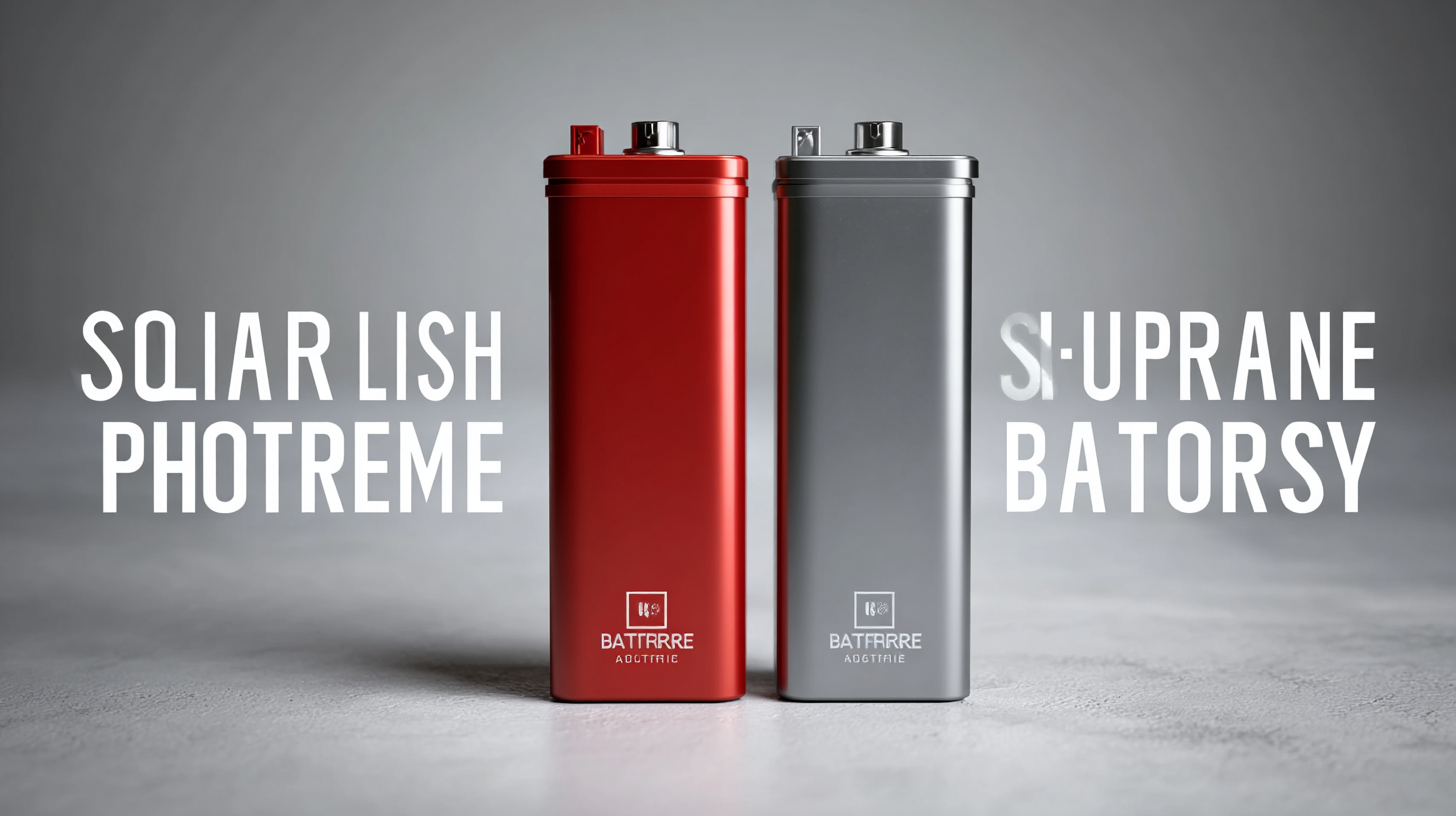As the demand for renewable energy continues to surge, the Solar Lithium Iron Phosphate Battery has emerged as a pivotal player in the solar energy landscape. According to the International Renewable Energy Agency (IRENA), the global lithium-ion battery market is projected to grow by 28% annually, emphasizing the increasing reliance on efficient and sustainable energy storage solutions.

Solar Lithium Iron Phosphate Batteries, known for their superior thermal stability, safe operation, and long cycle life, are becoming the preferred choice among homeowners and businesses alike. With experts predicting that the adoption of lithium iron phosphate technology in solar applications will significantly rise, it is crucial to understand the top products available in 2023. This blog provides a comprehensive comparison of the best Solar Lithium Iron Phosphate Batteries, aiming to guide consumers in making informed decisions for their energy storage needs.
Lithium iron phosphate (LFP) batteries continue to be a focal point in the renewable energy landscape, especially as we examine their role in the growing solar battery market. Known for their stability, safety, and long cycle life, LFP batteries present an appealing option for solar applications. As advancements in battery technology evolve, understanding the underlying mechanisms, such as the solid electrolyte interphase (SEI), and the implications of interface management become essential to improve performance and longevity. Recent research has highlighted the importance of these interfaces, suggesting that a deeper comprehension of their functions can lead to more efficient energy storage solutions.
The recycling of lithium-ion batteries, particularly LFP variants, is becoming increasingly critical as we move towards a circular economy. Innovations in recycling techniques are paving the way for sustainable practices, minimizing environmental impact while maximizing resource recovery. New approaches are emerging that not only enhance the efficiency of recycling processes but also address regulatory challenges and economic viability. As the technology matures, transitioned waste materials into valuable resources reinforces the potential for LFP batteries to contribute to a more sustainable future in energy storage and other applications. This synergy between technological innovation and environmental stewardship paints a promising picture for the continued integration of LFP batteries in our daily lives.
| Battery Capacity (Ah) | Nominal Voltage (V) | Cycle Life (Cycles) | Depth of Discharge (%) | Weight (kg) | Charge Rate (A) |
|---|---|---|---|---|---|
| 100 | 12.8 | 4000 | 80 | 12 | 50 |
| 200 | 12.8 | 3500 | 90 | 25 | 100 |
| 300 | 12.8 | 3000 | 85 | 50 | 150 |
| 400 | 12.8 | 5000 | 95 | 40 | 200 |
When considering solar lithium iron phosphate (LiFePO4) batteries, understanding the key industry standards is essential for ensuring optimal performance and safety. According to a recent report by the Solar Energy Industries Association (SEIA), adherence to standards set by the International Electrotechnical Commission (IEC) significantly enhances the reliability of solar battery systems. Specifically, IEC 62619 outlines the safety requirements for large-format lithium-ion batteries, which are crucial for preventing thermal runaway and ensuring longevity. Batteries compliant with these standards can achieve a cycle life of over 3,000 cycles, as indicated in a study by the Battery University, demonstrating their effectiveness in sustainable energy solutions.

Another pivotal standard to consider is UL 1973, which addresses battery systems for use in stationary applications. This certification focuses on the battery's safety during operation, including abuse testing and environmental conditions. A report from the National Renewable Energy Laboratory (NREL) emphasizes that batteries meeting UL 1973 standards not only provide greater safety but also enhance energy efficiency by up to 20% compared to non-certified options. As the demand for reliable solar storage solutions grows, manufacturers that prioritize compliance with these industry standards will lead the market, providing consumers with safer and more effective energy storage configurations.
When it comes to selecting the best solar lithium iron phosphate (LiFePO4) batteries for 2023, understanding the core features of each option is essential. The primary attributes to consider include capacity, discharge rate, lifespan, and thermal stability. For instance, some leading models boast a high energy density and a longer cycle life, making them ideal for extended use in off-grid solar systems. Additionally, superior thermal management systems can ensure safety and reliability during operation, particularly in varying climate conditions.
Another crucial aspect to evaluate is the battery's compatibility with existing solar setups. Many solar lithium iron phosphate batteries are designed with integrated management systems that facilitate easy installation and configuration with solar inverters and other components. Furthermore, examining the warranty and customer support options can provide insights into the long-term value of the investment. By focusing on these feature comparisons, users can make informed decisions and select the battery that best meets their energy needs while maximizing efficiency and performance.
When selecting the best solar battery for your needs, particularly lithium iron phosphate (LiFePO4) batteries, it is essential to consider several factors that might influence your investment decision. The market for microinverters, anticipated to grow from $4.12 billion in 2024 to $15.4 billion by 2032 with a CAGR of 17.92%, indicates a robust shift towards solar energy solutions. This growth reflects increasing consumer demand for efficient and sustainable energy storage systems, which underscores the importance of selecting the right battery type that aligns with your specific energy needs.
**Tip:** Evaluate the capacity and lifespan of the battery. LiFePO4 batteries offer excellent longevity and safety, making them a strong option for residential solar setups. Also, consider the charging and discharging efficiency, as these metrics can significantly impact your overall energy savings and system performance.
Another crucial consideration is potential misconceptions surrounding solar systems. Many consumers are misled into underestimating the long-term benefits of investing in solar energy and battery storage. For instance, the recent surge in solar installations following favorable policy changes highlights the importance of clear communication regarding the actual benefits and requirements of solar technology.
**Tip:** Always conduct thorough research and consult with experts before making an investment. Understanding the full potential of solar technologies can help households make informed decisions for sustainable energy solutions.
As the solar energy sector continues to grow, the development of lithium iron phosphate (LiFePO4) batteries is poised to play a crucial role in enhancing efficiency and sustainability. According to a report by Research and Markets, the LiFePO4 battery market is expected to reach approximately $8.2 billion by 2026, reflecting a compound annual growth rate (CAGR) of 20%. This growth is driven by the increasing demand for renewable energy solutions and the ongoing advancements in battery technology, particularly in enhancing energy density and lifespan.
Future trends in the development of solar LiFePO4 batteries are likely to be influenced by stricter industry standards and innovations aimed at increasing safety and performance. The International Electrotechnical Commission (IEC) is currently working on new testing protocols that will improve the reliability of lithium-ion batteries in solar applications. Additionally, the push towards larger-scale energy storage solutions signifies a shift toward integrating smart technology that allows for greater efficiency and monitoring capabilities. This combined focus on quality standards and technological advancement will not only facilitate wider adoption of solar energy but also foster a more sustainable future.



